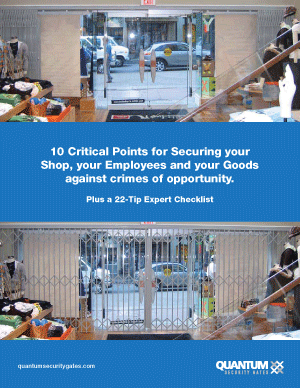Physical Security and Shoplifting
When many people think of security gates, they think of tools that help prevent smash and grab robberies. This is true. Security gates are incredibly effective at preventing break-ins, smash and grab robberies and other crimes. But did you know that they also reduce the likelihood of shoplifting?
Shoplifting costs business across North America billions of dollars. According to studies, retail crime costs Canadian retailers $3.6 billion per year. Ipsos Reid states that small independent retailers lose an average of $1000 per month to shoplifting. When it comes to larger retailers, 28% report losses of more than $500,000 due to organized retail crime. As you can see, shoplifting is costly.
Small yet valuable items are frequently targeted by shoplifters. This is for obvious reasons. One, because these items can easily be slipped into a pocket or bag without anyone noticing. Two, because they are lightweight and can be carried from the store easily. Three, because these items typically cost quite a lot to buy and/or they can be sold for a lot of money on the black market.
According to the Global Theft Barometer-Center for Retail Research 2008 Report, these are the most commonly shoplifted items:
- Razor blades
- Alcohol
- Toiletries, cosmetics and fragrances
- Clothing and lingerie
- Batteries
- DVDs, CDs and video games
- Pills, vitamins, contraceptives and pregnancy testers.
- Electric toothbrushes
- Instant coffee
- Packs of meat
Reduce Shoplifting Opportunities
You may not think of physical security when it comes to preventing shoplifting, but it can be a crucial tool. As mentioned, shoplifters like to sneak items off of shelves and racks without being noticed. Physical security makes this significantly more difficult.
Stores that lock small yet valuable items in cabinets or behind secure gates can drastically decrease the amount of shoplifting that takes place. Shoplifters thrive on not being noticed. If they have to ask for an item or if they need to speak to a store employee in order to purchase an item, you cause them to be noticed. Shoplifters often avoid properties that utilize physical security gates and locked cabinets to protect merchandise as it isn’t worth their time.
Using physical security also reduces employee theft as these tools also function as a form of access control. You can ensure that only trusted employees can have keys to the locked gates and cabinets, reducing the likelihood of theft. If anything is stolen, you will be able to narrow down who could have possibly committed the crime by looking at who has keys to that area.
As you can see, physical security tools serve a number of purposes when it comes to protecting a property. These gates not only provide security, but they also make existing security tools more effective. For example, security cameras are more likely to capture a crime in progress if the criminal is attempting to get around a security gate. This act is significantly more visible that someone slipping an item into his or her pocket, and thus the chances of this person being caught are much greater.


